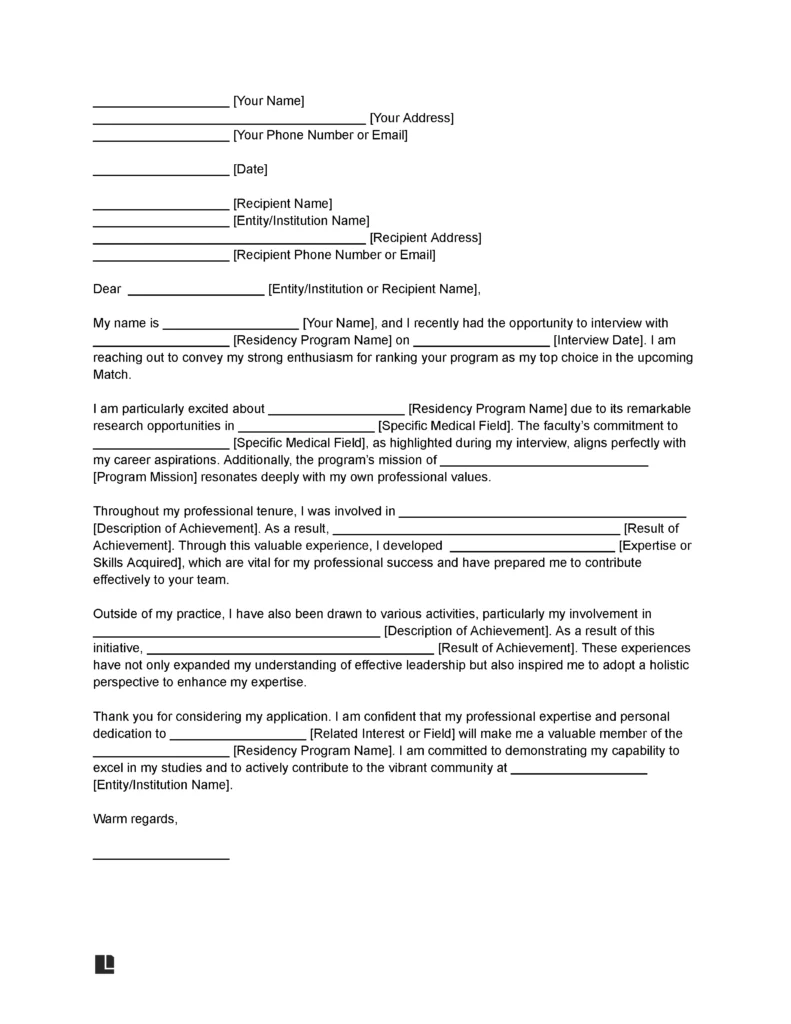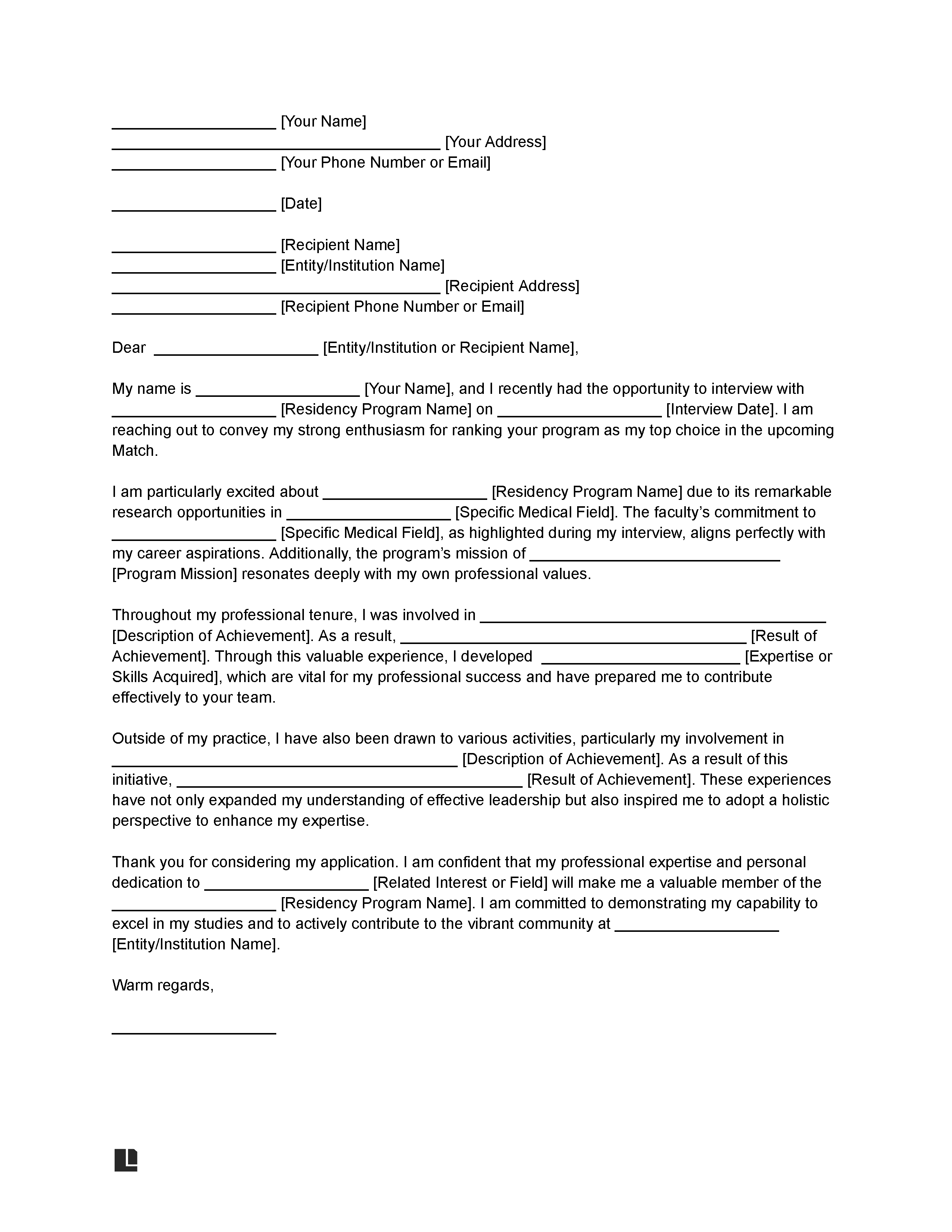A medical residency letter of intent is a short, concise letter written at the end of the Match season to communicate to your top-choice medical residency program that they are your preferred choice and explain why. This letter, addressed to residency program directors, is intended to affirm your desire to join their program if matched.
Applying to residency programs involves a lengthy process that continues even after interviews. Applicants must create an NRMP Rank Order List of preferred programs. While not mandatory, many candidates send a letter of intent to potentially gain an advantage over other applicants.
When to Send
You may send a residency letter of intent only to your top-choice program, clearly stating it as your number one preference. Writing to multiple programs can backfire, as it shows they’re not your first choice and makes their exact ranking unclear, potentially leading program directors to question why they’re not your top pick.
Letter of Intent vs. Letter of Interest
Letter of Interest: Sent at the beginning of the Match season, this letter aims to secure interviews by highlighting your enthusiasm, unique qualities, and relevant experiences.
Letter of Intent: Sent at the end of the Match season to your top-choice program, it explicitly states that they are your number one choice and reiterates your fit and commitment based on interview insights.
Key Differences:
- Purpose: Interest secures interviews; Intent influences ranking.
- Timing: Interest is sent early; Intent is sent late.
- Content: Interest highlights unique attributes; Intent emphasizes commitment and fit.
Understanding the Match Process
The primary system facilitating securing a residency position in the United States is the National Resident Matching Program (NRMP), commonly referred to as “The Match.” Here’s a brief overview to help you understand where a Residency Letter of Intent fits into this process:
1. Application and Interview Phase
- ERAS and CaRMS: US residency applicants use the Electronic Residency Application Service (ERAS), while Canadian applicants use the Canadian Resident Matching Service (CaRMS).
- Interviews: After submitting applications, programs review them and invite selected candidates for interviews during the fall and winter of their final year in medical school.
2. Rank Order Lists (ROL)
- Applicants’ ROL: After interviews, applicants rank the programs they wish to join in order of preference.
- Programs’ ROL: Similarly, residency programs rank the applicants they wish to accept.
3. The Matching Algorithm
The NRMP uses a matching algorithm that pairs applicants and programs based on:
- Number of Available Positions: The number of slots a program has.
- Programs’ Preferences: How programs rank the applicants.
- Applicant’s Preferences: How applicants rank the programs.
On the Monday of Match Week in March, applicants find out whether they have matched to a residency program, but the exact program remains undisclosed until Friday. For those who do not match initially, the Supplemental Offer and Acceptance Program (SOAP) provides another opportunity to secure a position.
The Role of a Letter of Intent in the Match Process
If you’ve reached the interview stage and have identified your top-choice program, a Residency Letter of Intent can be a strategic tool to enhance your chances of matching. Here’s why and how it matters:
- Express Strong Interest: It demonstrates your commitment and genuine interest in the program, signaling to the directors that you are serious about joining their team.
- Competitive Edge: Programs prefer candidates who show a keen interest in them. Sending a letter might increase your chances of being ranked higher on their ROL.
- Mutual Match Assurance: Programs aim to fill their positions with candidates who are likely to join if offered a spot. Your letter reassures them that you are highly likely to accept their offer.
When and How to Send
- Timing: After your interviews and before programs finalize their ROLs.
- Content: Clearly state why the program is your top choice, reflect on your interview experience, and reiterate your fit and enthusiasm for the program.
Step-by-Step Guide to Writing a Residency Letter of Intent
Your residency letter of intent should be concise, professional, and no longer than one page (200-300 words). Here’s a step-by-step guide to help you create a compelling letter:
Step 1: Introduction
-
Start with a clear opening paragraph.
- Introduce yourself.
- Mention the date of your interview.
- State your intention to rank this program as your top choice.
Example:
“My name is [Your Name], and I had the pleasure of interviewing with your program on [Interview Date]. I am writing to express my strong interest in ranking [Program Name] as my number one choice in the upcoming Match.”
Step 2: Body Paragraphs
Explain why this program is your first choice
- Highlight specific aspects of the program that excite you.
- Mention any research opportunities or unique features that appeal to you.
- Refer to your interview experiences that solidified your decision.
Example:
“I am particularly drawn to [Program Name] because of its outstanding research opportunities in [specific field]. During my interview, I was impressed by the faculty’s commitment to [specific aspect], which aligns perfectly with my career aspirations. The program’s mission of [program’s mission/values] resonates deeply with my own professional values.”
Show how you are a great fit for the program
- Provide examples from your past that demonstrate alignment with the program’s values.
- Explain how your skills and experiences will contribute to the program.
- Describe how the program will help you achieve your goals.
Example:
“Throughout my medical training, I have actively engaged in [specific activities or roles] that reflect the values upheld by [Program Name]. My experience in [specific skill or experience] has prepared me to contribute effectively to your team. I am confident that the resources and mentorship available at [Program Name] will be instrumental in achieving my short-term and long-term goals in [specific career path].”
Include any relevant updates
- Mention new publications, volunteer experiences, or employment that enhance your application.
Example:
“I am also pleased to share that my recent research on [topic] has been accepted for publication in [Journal Name]. Additionally, I have continued to volunteer with [Organization], further enriching my experience in [relevant field].”
Step 3: Conclusion
- Summarize your reasons and reiterate your ranking decision.
Example:
“In conclusion, I am deeply impressed by the exceptional training and supportive environment at [Program Name]. I am confident that this program is the ideal place for me to grow both professionally and personally. I am enthusiastic about ranking [Program Name] as my top choice and am eager for the opportunity to contribute to and thrive in your esteemed program.”
Medical Residency Letter of Intent Sample
Download a customizable template available in PDF or MS Word formats.


